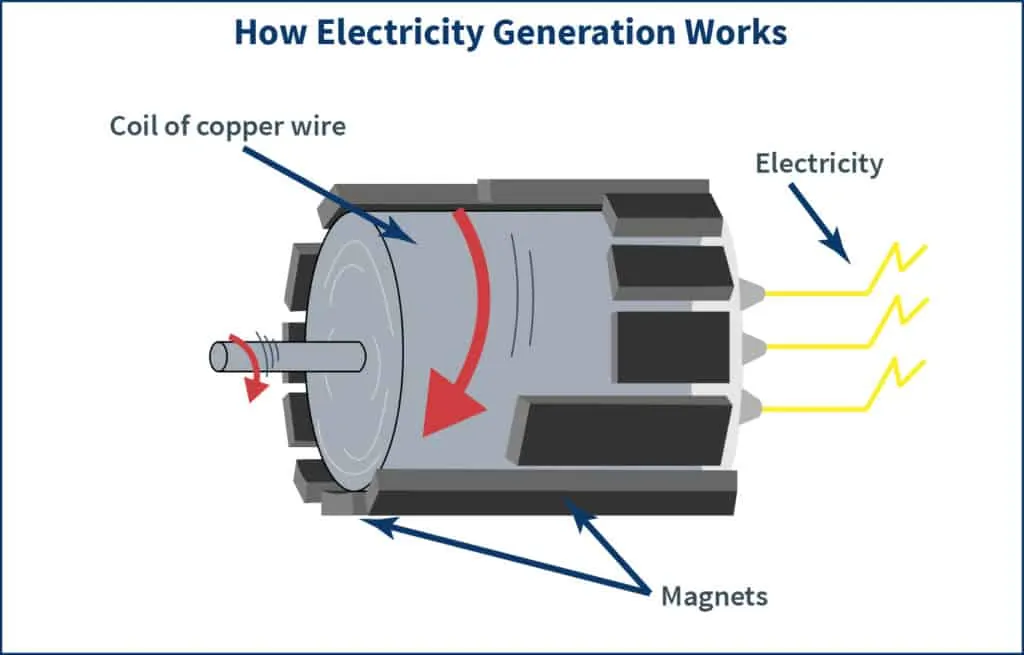Electricity is generated through various methods that convert different forms of energy into electrical power. The most common methods include burning fossil fuels like coal, natural gas, and oil in power plants to produce steam, which drives turbines connected to generators. Nuclear power plants use nuclear reactions to generate heat, which similarly produces steam for turbines. Renewable sources like hydroelectric plants use flowing water to spin turbines, while wind farms harness wind energy with wind turbines. Solar power converts sunlight directly into electricity using photovoltaic cells. Each of these methods involves turning kinetic or potential energy into the mechanical motion of turbines, which is then converted into electrical energy by generators.

Types of Electricity Generation
- Fossil Fuel Power Plants: Use coal, natural gas, and oil to generate steam that drives turbines.
- Nuclear Power Plants: Utilize nuclear reactions to produce heat and steam, driving turbines.
- Hydroelectric Power Plants: Harness the energy of flowing or falling water to spin turbines.
- Wind Farms: Use wind turbines to convert wind energy into electrical power.
- Solar Power: Convert sunlight directly into electricity using photovoltaic cells.
- Geothermal Power Plants: Extract heat from beneath the Earth’s surface to generate steam and drive turbines.
- Biomass Power Plants: Burn organic materials like wood, agricultural residues, and waste to produce steam for turbines.
- Tidal and Wave Power: Use the movement of tides and ocean waves to generate electricity.
- Combined Heat and Power (CHP) Plants: Generate electricity and capture usable heat that is produced in the process.
- Fuel Cells: Convert chemical energy from fuels like hydrogen into electricity through a chemical reaction.
Conventional Methods of Electricity Generation
- Coal-Fired Power Plants: Burn coal to produce steam that drives turbines connected to generators.
- Natural Gas Power Plants: Use natural gas combustion to generate electricity, often through combined cycle systems that improve efficiency.
- Oil-Fired Power Plants: Burn oil to heat water and produce steam for turbine operation.
- Nuclear Power Plants: Utilize nuclear fission to generate heat, creating steam that drives turbines.
- Hydroelectric Power Plants: Employ the energy of flowing or falling water to spin turbines and generate electricity.
- Diesel Power Plants: Use diesel engines to directly drive generators, typically used for backup or remote power generation.
Thermal Power Plants
Thermal power plants generate electricity by converting heat energy into electrical energy. The process typically involves burning fossil fuels like coal, oil, or natural gas to produce heat. This heat is used to convert water into steam, which then drives steam turbines connected to generators. There are different types of thermal power plants, including:
- Coal-Fired Power Plants: Burn coal to produce steam.
- Oil-Fired Power Plants: Use oil as the fuel to generate steam.
- Natural Gas Power Plants: Burn natural gas, often using a combined cycle system that improves efficiency by utilizing both gas and steam turbines.
- Nuclear Power Plants: Generate heat through nuclear fission reactions, using the heat to produce steam.
- Biomass Power Plants: Use organic materials such as wood, agricultural waste, or other biomass to produce heat and steam.
Renewable Methods of Electricity Generation
- Solar Power: Converts sunlight directly into electricity using photovoltaic (PV) cells. Solar thermal power plants use mirrors to concentrate sunlight, producing heat to generate steam for turbines.
- Wind Power: Utilizes wind turbines to convert the kinetic energy of wind into electrical energy.
- Hydropower: Generates electricity by harnessing the energy of flowing or falling water. This can include large-scale dams as well as smaller run-of-the-river setups.
- Geothermal Power: Extracts heat from beneath the Earth’s surface to produce steam, which drives turbines connected to generators.
- Biomass Energy: Uses organic materials like wood, agricultural waste, and other biomass to produce heat and electricity through combustion or other processes such as anaerobic digestion.
- Tidal Power: Captures the energy of tidal movements to generate electricity, often using underwater turbines.
- Wave Power: Converts the energy of ocean waves into electrical power through various technologies like oscillating water columns or point absorbers.
- Ocean Thermal Energy Conversion (OTEC): Utilizes the temperature difference between warmer surface water and colder deep water to generate electricity.
- Hydrogen Fuel Cells: Produce electricity through a chemical reaction between hydrogen and oxygen, emitting only water as a byproduct.
Conclusion
Electricity generation is a crucial component of modern society, powering homes, industries, and infrastructure. There are various methods of generating electricity, ranging from conventional thermal power plants that burn fossil fuels or utilize nuclear reactions, to renewable energy sources like solar, wind, hydropower, and geothermal energy. While traditional methods have provided reliable energy for decades, they often come with significant environmental impacts, including greenhouse gas emissions and pollution. On the other hand, renewable energy sources offer cleaner, sustainable alternatives that can help mitigate climate change and reduce dependence on finite resources. The ongoing shift towards renewable energy is essential for achieving a sustainable and environmentally friendly energy future.
FAQs
Q: 1What are the main methods of generating electricity?
Ans: Electricity can be generated through various methods, including burning fossil fuels (coal, natural gas, oil) in power plants, nuclear fission in nuclear power plants, harnessing renewable energy sources such as wind, solar, hydropower, geothermal, and using biomass or hydrogen fuel cells.
Q:2 How does a coal-fired power plant generate electricity?
Ans In a coal-fired power plant, coal is burned to produce heat, which converts water into steam. This steam drives turbines connected to generators, which then produce electricity.
Q:3 What is the role of turbines in electricity generation?
Ans Turbines play a crucial role in electricity generation by converting kinetic energy (from steam, wind, water, etc.) into mechanical energy. This mechanical energy is then transformed into electrical energy by generators.
Q: 4. How do solar panels generate electricity?
Ans: Solar panels generate electricity by converting sunlight directly into electrical energy using photovoltaic (PV) cells. When sunlight hits these cells, it creates an electric current that can be harnessed for power.






